Old Town Eureka
Old Town Eureka (formally the Eureka Old Town Historic District) in Eureka, California, is listed on the United States National Register of Historic Places. This Historic district is a 350-acre (1.4 km2) area containing 154 buildings[2] mostly from the Victorian era. The core of the district runs the length of First, Second, and Third Streets, between "C" and "M" Streets and includes many types of architecture from the 1850s to the present. Though not officially within the district, the Carson Mansion, the undisputed Victorian jewel of the city and region, commands the highest elevation at the eastern edge of the district.
Old Town Eureka (Eureka Old Town Historic District) | |
 Near 2nd & "F" Streets in Old Town | |
  | |
| Location | Eureka, California-Roughly, 1st, 2nd, & 3rd Streets, between B and M Streets. |
|---|---|
| Coordinates | 40°48′13.34″N 124°9′59.04″W |
| Built | 1850-1874, 1875-1899, 1900-1924, 1925-1949 |
| Architect | Multiple |
| Architectural style | Victorian, Greek Revival, Classical Revival (Neoclassical) |
| NRHP reference No. | 91001523[1] |
| Added to NRHP | 1991 |
History
The city began as an 1850 settlement on the edge of Humboldt Bay where the district is today. Developers and settlers planned for Eureka to aid in the provision of miners working inland to the east. By 1865 the central core of what would become Eureka's "Old Town" was considered "a lively place for a small town, full of business and with plenty of money... the roads beyond Second street (the equivalent of "Main" Street) were covered with stumps from the (recently logged) Redwood forest and not yet open.[3]
Old Town today

Old Town is the thriving, cultural heart of Eureka, California and the region. The area is an attraction for visitors and homeless alike. Its placement on the California North Coast is indisputably beautiful. The area, often shrouded in fog and very definitely behind the Redwood Curtain, is very different from the rest of California. The vibrant art scene that has grown up there in the final decades of the 20th century led to the declaration that the city was one of the 100 best art towns in America.[4] Among restaurants and inns, are multiple bed and breakfasts, including the award-winning Carter House Inn Restaurant 301, noted for repeatedly winning the "Grand Award" from Wine Spectator Magazine due to extensive collection of wine.
The Clarke Historical Museum is located at the corner of 3rd and E Streets. The collection includes extensive representation of basketry of indigenous native cultures throughout the region and regional and cultural history, with focus on the Victorian era.
Culture
- Blues By the Bay occurs in late summer on City of Eureka property below the Carson Mansion.
- First Saturday Arts Alive! occurs each month in the Old Town and Downtown sections of Eureka. More than 80 local galleries and other shops display local art to the public. The open house event often features wine, non-alcoholic drinks, and hors d'oeuvres. Musicians, performers, jugglers, poets and fire dancers perform on street corners as well as in shops and galleries. The event often coincides with performances of the Eureka Symphony in the Arkley Performance Center in the refurbished "Old" State Theater Building. Children can be safely cared for in the Discovery Museum, while parents participate in the North State's largest ongoing community arts event.
- Old Town Eureka has a street-fair Fourth of July celebration followed by fireworks over the bay.
Examples of historic architecture in Old Town
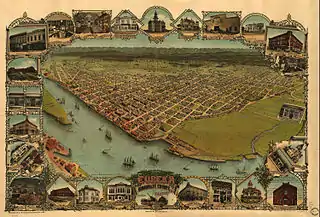 1902 Illustration of City of Eureka. Old Town is the area of the city, primarily on the waterfront near the island on the left.
1902 Illustration of City of Eureka. Old Town is the area of the city, primarily on the waterfront near the island on the left.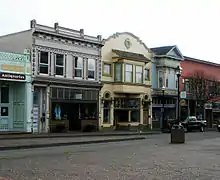 Victorian Commercial buildings on the south side of Second Street.
Victorian Commercial buildings on the south side of Second Street. The Clarke Historical Museum, located in the former Bank of Eureka, designed by Albert Pissis, 1911.
The Clarke Historical Museum, located in the former Bank of Eureka, designed by Albert Pissis, 1911. The Buon Gusto (Eagle House) Hotel from the era when travel to Humboldt Bay was primarily by ship. Docks for ships from San Francisco were nearby this corner, which at one time had four of these hotels.
The Buon Gusto (Eagle House) Hotel from the era when travel to Humboldt Bay was primarily by ship. Docks for ships from San Francisco were nearby this corner, which at one time had four of these hotels.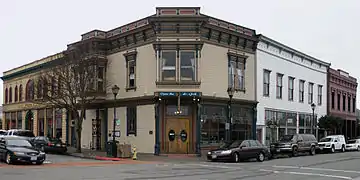 1893-1904 Commercial Buildings
1893-1904 Commercial Buildings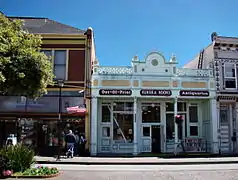 Bookstore: A Late 1870s Store Front on Second Street.
Bookstore: A Late 1870s Store Front on Second Street. The Carson Mansion as viewed from Humboldt Bay.
The Carson Mansion as viewed from Humboldt Bay.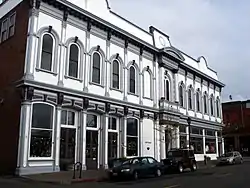 Second Empire Independent Order of Odd Fellows Hall building with original commercial space on the first floor.
Second Empire Independent Order of Odd Fellows Hall building with original commercial space on the first floor.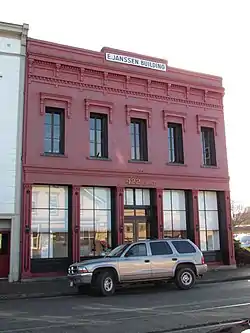 Humboldt Arts Council in mid-1800s (early) commercial brick building.
Humboldt Arts Council in mid-1800s (early) commercial brick building.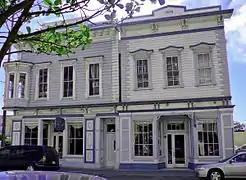 Victorian detailed Commercial Building. Now a popular local seafood restaurant.
Victorian detailed Commercial Building. Now a popular local seafood restaurant.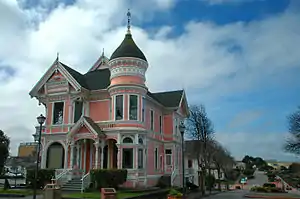 Milton Carson Home: a wedding gift for the son of the early Lumber Baron, William Carson, who built the Carson Mansion, 1889.
Milton Carson Home: a wedding gift for the son of the early Lumber Baron, William Carson, who built the Carson Mansion, 1889.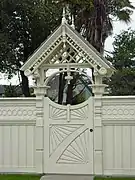 Victorian fencing and gate to the side yard of the Milton Carson Home.
Victorian fencing and gate to the side yard of the Milton Carson Home.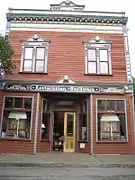 Original Commercial Building with "false" front on 2nd Street.
Original Commercial Building with "false" front on 2nd Street.
References
- National Register of Historic Places
- Historic Sites in Humboldt County, California
- Overhold, Ken (Editor) (1994) [1987]. Eureka: An Architectural Heritage (Second ed.). Eureka, California: Eureka Heritage Society. p. 270. ISBN 0-9615004-0-9.CS1 maint: extra text: authors list (link)
- Villani, John (October 1998). The 100 Best Small Art Towns in America (3rd ed.). Berkeley, California: Avalon Travel Publishing. pp. 256. ISBN 1-56261-405-3.
External links
| Wikimedia Commons has media related to Old Town Eureka. |
- General guides
- Eureka Old Town
- Old Town and Downtown Eureka
- Humboldt County Convention and Visitors Bureau
- Old Town Eureka
- The "Hum Guide:" Extensive area resources and information
- Arts, music & museums